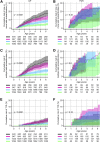Genetic Contribution to the Divergence in Type 1 Diabetes Risk Between Children From the General Population and Children From Affected Families
- PMID: 30655385
- PMCID: PMC6425872
- DOI: 10.2337/db18-0882
Genetic Contribution to the Divergence in Type 1 Diabetes Risk Between Children From the General Population and Children From Affected Families
Abstract
The risk for autoimmunity and subsequently type 1 diabetes is 10-fold higher in children with a first-degree family history of type 1 diabetes (FDR children) than in children in the general population (GP children). We analyzed children with high-risk HLA genotypes (n = 4,573) in the longitudinal TEDDY birth cohort to determine how much of the divergent risk is attributable to genetic enrichment in affected families. Enrichment for susceptible genotypes of multiple type 1 diabetes-associated genes and a novel risk gene, BTNL2, was identified in FDR children compared with GP children. After correction for genetic enrichment, the risks in the FDR and GP children converged but were not identical for multiple islet autoantibodies (hazard ratio [HR] 2.26 [95% CI 1.6-3.02]) and for diabetes (HR 2.92 [95% CI 2.05-4.16]). Convergence varied depending upon the degree of genetic susceptibility. Risks were similar in the highest genetic susceptibility group for multiple islet autoantibodies (14.3% vs .12.7%) and diabetes (4.8% vs. 4.1%) and were up to 5.8-fold divergent for children in the lowest genetic susceptibility group, decreasing incrementally in GP children but not in FDR children. These findings suggest that additional factors enriched within affected families preferentially increase the risk of autoimmunity and type 1 diabetes in lower genetic susceptibility strata.
Trial registration: ClinicalTrials.gov NCT00279318.
© 2019 by the American Diabetes Association.
Figures




Similar articles
-
Accelerated progression from islet autoimmunity to diabetes is causing the escalating incidence of type 1 diabetes in young children.J Autoimmun. 2011 Aug;37(1):3-7. doi: 10.1016/j.jaut.2011.02.004. Epub 2011 Mar 3. J Autoimmun. 2011. PMID: 21376535 Free PMC article.
-
Progression from islet autoimmunity to clinical type 1 diabetes is influenced by genetic factors: results from the prospective TEDDY study.J Med Genet. 2019 Sep;56(9):602-605. doi: 10.1136/jmedgenet-2018-105532. Epub 2018 Oct 4. J Med Genet. 2019. PMID: 30287597 Free PMC article.
-
Do non-HLA genes influence development of persistent islet autoimmunity and type 1 diabetes in children with high-risk HLA-DR,DQ genotypes?Diabetes. 2009 Apr;58(4):1028-33. doi: 10.2337/db08-1179. Epub 2009 Feb 2. Diabetes. 2009. PMID: 19188433 Free PMC article.
-
Humoral beta-cell autoimmunity in relation to HLA-defined disease susceptibility in preclinical and clinical type 1 diabetes.Am J Med Genet. 2002 May 30;115(1):48-54. doi: 10.1002/ajmg.10343. Am J Med Genet. 2002. PMID: 12116176 Review.
-
The environment and the origins of islet autoimmunity and Type 1 diabetes.Diabet Med. 2013 Feb;30(2):155-60. doi: 10.1111/dme.12099. Diabet Med. 2013. PMID: 23252770 Free PMC article. Review.
Cited by
-
ISPAD Clinical Practice Consensus Guidelines 2024: Screening, Staging, and Strategies to Preserve Beta-Cell Function in Children and Adolescents with Type 1 Diabetes.Horm Res Paediatr. 2024;97(6):529-545. doi: 10.1159/000543035. Epub 2024 Dec 11. Horm Res Paediatr. 2024. PMID: 39662065 Free PMC article. Review.
-
Time to reframe the disease staging system for type 1 diabetes.Lancet Diabetes Endocrinol. 2024 Dec;12(12):924-933. doi: 10.1016/S2213-8587(24)00239-0. Lancet Diabetes Endocrinol. 2024. PMID: 39608963 Review.
-
Incomplete time-series gene expression in integrative study for islet autoimmunity prediction.Brief Bioinform. 2023 Jan 19;24(1):bbac537. doi: 10.1093/bib/bbac537. Brief Bioinform. 2023. PMID: 36513375 Free PMC article.
-
The countdown to type 1 diabetes: when, how and why does the clock start?Diabetologia. 2023 Jul;66(7):1169-1178. doi: 10.1007/s00125-023-05927-2. Epub 2023 May 26. Diabetologia. 2023. PMID: 37231274 Free PMC article. Review.
-
Systematic immune cell dysregulation and molecular subtypes revealed by single-cell RNA-seq of subjects with type 1 diabetes.Genome Med. 2024 Mar 27;16(1):45. doi: 10.1186/s13073-024-01300-z. Genome Med. 2024. PMID: 38539228 Free PMC article.
References
-
- Schenker M, Hummel M, Ferber K, et al. . Early expression and high prevalence of islet autoantibodies for DR3/4 heterozygous and DR4/4 homozygous offspring of parents with type I diabetes: the German BABYDIAB study. Diabetologia 1999;42:671–677 - PubMed
Publication types
MeSH terms
Substances
Associated data
Grants and funding
- U01 DK063821/DK/NIDDK NIH HHS/United States
- UC4 DK063863/DK/NIDDK NIH HHS/United States
- DP3 DK111906/DK/NIDDK NIH HHS/United States
- HHSN267200700014C/DK/NIDDK NIH HHS/United States
- U01 DK063861/DK/NIDDK NIH HHS/United States
- U01 DK063790/DK/NIDDK NIH HHS/United States
- UL1 TR001082/TR/NCATS NIH HHS/United States
- P30 DK017047/DK/NIDDK NIH HHS/United States
- UL1 TR000064/TR/NCATS NIH HHS/United States
- U01 DK063836/DK/NIDDK NIH HHS/United States
- U01 DK063829/DK/NIDDK NIH HHS/United States
- U01 DK063865/DK/NIDDK NIH HHS/United States
- UC4 DK095300/DK/NIDDK NIH HHS/United States
- UC4 DK063861/DK/NIDDK NIH HHS/United States
- UC4 DK063829/DK/NIDDK NIH HHS/United States
- UC4 DK063821/DK/NIDDK NIH HHS/United States
- UC4 DK117483/DK/NIDDK NIH HHS/United States
- UC4 DK063836/DK/NIDDK NIH HHS/United States
- UC4 DK112243/DK/NIDDK NIH HHS/United States
- UC4 DK063865/DK/NIDDK NIH HHS/United States
- U01 DK063863/DK/NIDDK NIH HHS/United States
- UC4 DK106955/DK/NIDDK NIH HHS/United States
- UC4 DK100238/DK/NIDDK NIH HHS/United States
LinkOut - more resources
Full Text Sources
Other Literature Sources
Medical
Research Materials

